


The Muscari neglectum 'Grape hyacinth' is the traditional petite 'Grape Hyacinth'. Its small purple flowers appear 2-3 inches above its small fountain of grass-like foliage and bloom some time in late February or early March. The color makes a wonderful contrast with other March blooming bulbs such as the 'Golden Dawn', 'Lent lily', 'Campernelle', 'Carlton', or next to your bright tulips. Like the 'Hoop Petticoat' and 'Jonquil', it can reproduce by seed, allowing it to naturalize in many settings of Southern landscapes.
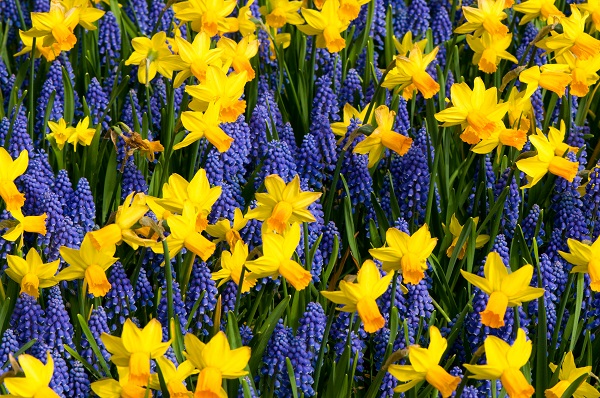
Why do they look so good together? Yellow will catch your eye, but it is the purple that keeps you looking. Purple and yellow are complementary colors on the color wheel so they look good together naturally. When complementary colors are placed next to each other, they provide color intensity, pop, emphasis, vibrancy, boldness, and visual interest. Complementary colors can enhance the intensity and brightness of each other, making the colors appear more vivid and striking which creates a bold and dynamic visual impact. This is used to draw one's attention.

White and purple also create a harmonious combination. The white provides a sense of calm which allows the purple to pop and really draw attention to itself and the white. This color combination feels fresh and elegant.

This bulb works as a wonderful carpet, often spreading across yards over a period of years. It also serves as a graceful border for the base of deciduous trees. These are smaller bulbs, and have a tendency to dry out, so be sure to plant them as soon as possible! They are striking when planted in en masse of 60+ bulbs. If you want to try planting them en masse, simply dig a trench about 3-4 inches deep, place the bulbs about 1-2" apart, and cover the entire area with soil. Then water.
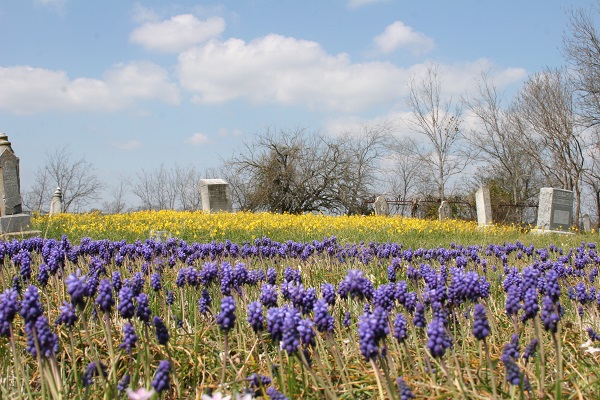
What to expect: This bulb will put on its foliage in February to prepare for its March bloom. The flowers only reach about 6" tall. Each bulb will produce 1-3 flowering stems, and each stem will produce a cluster of "grape-like" florets that give off a light grape fragrance. The lovely blooms will last for 2-3 weeks, but the green foliage will add to your garden for at least another month. Allow the foliage to die back naturally. When it is completely dead, then you can cut if off. Remember, the foliage is what takes in the sun energy to allow the bulbs to make it through the year and produce beautiful blooms the next year. Occasionally, if the weather is just right, the grape hyacinth may put on foliage again in the fall. The foliage may last all winter long if it is a mild winter. Don't worry though if a cold snap affects the foliage. It won't bother the bulb. Think of it like "bonus" nourishment.
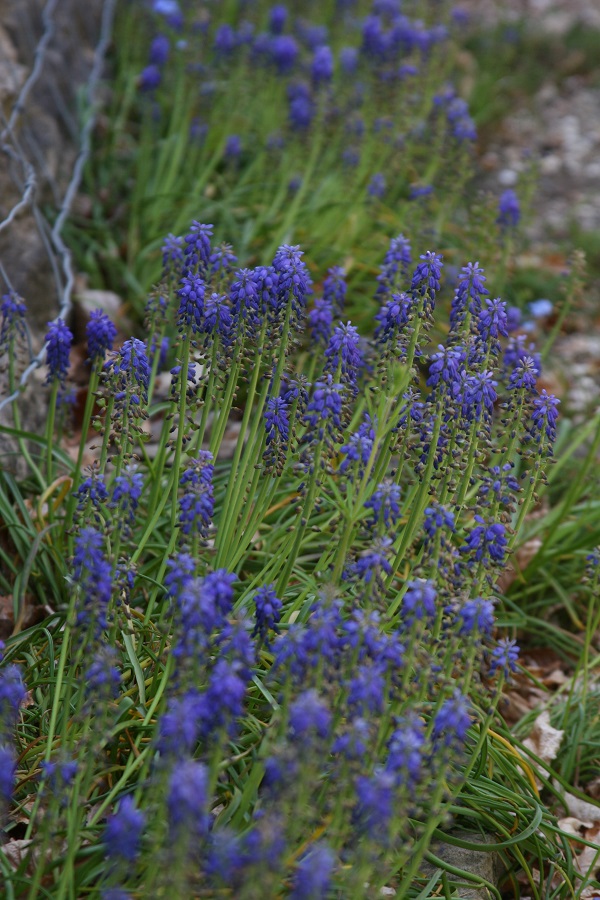
Care and planting: These bulbs do best when planted in zones 4-9 where they will receive at least 6+ hours of winter sun. Simply plant them 2-3 times deep the size of the bulb. Plant the bulbs 1-2" apart if you want them to look more natural or up to 6" apart if you are planning to let them fill in the area over the next few years. The size of this bloom allows it to look great in containers, as a border, along walkways, in rock gardens, or in an open area. They like well-drained soil.
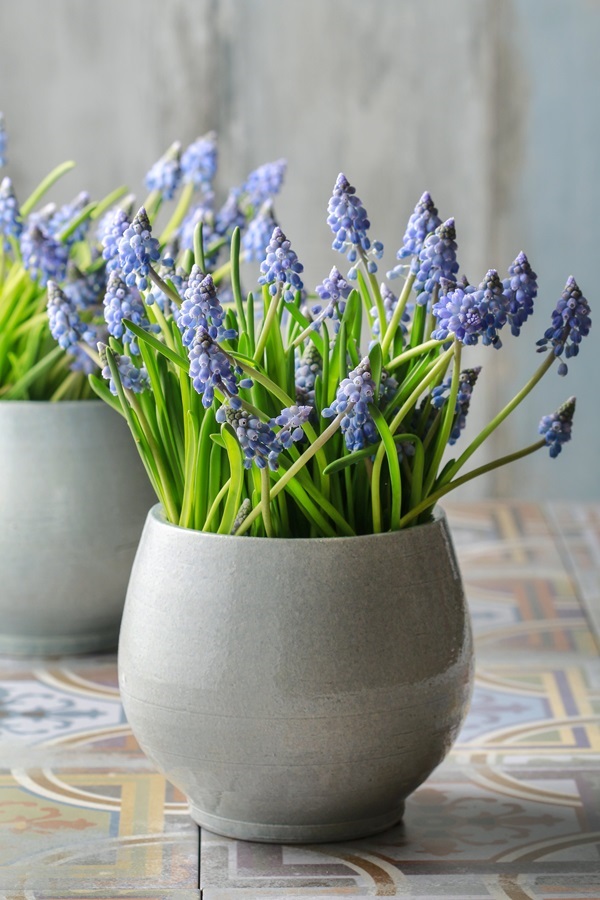
Plant in pots: Can I plant them in pots? Yes! They still need that winter sun though so be sure to place the pot in a very sunny location that will receive 6+ hours of sun. Just water them a little until the foliage and blooms start to appear and then be sure to water them a little more. Place them in a pot with well-drained soil. Like the pot above, you can plant a lot of bulbs in a small pot to have a dramatic showing. If the weather is nice between February and May, you can set the pot outside to take in great nutrients directly from the sun. Be sure to keep the pot out of the temperatures below 34 degrees as the pot gets cold from all sides and can freeze the bulbs. Remember that the bulbs will multiply so after the foliage has died back you may want to go ahead and transplant some of the bulbs into other pots for the next season. Small pots of grape hyacinth look beautiful around the house for spring entertaining.

Animals: Bees are very attracted to 'Grape Hyacinth', but deer tend to treat it like daffodils and leave it alone.
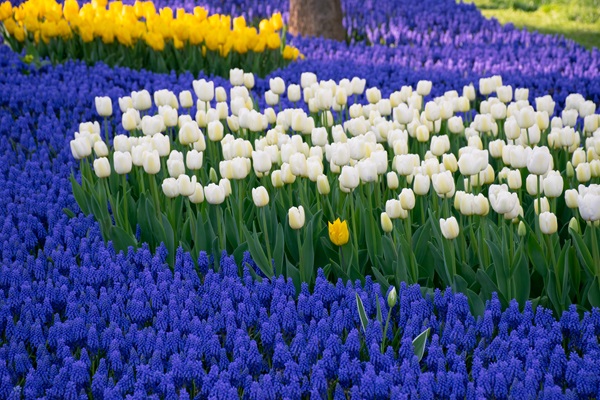

The Muscari neglectum 'Grape hyacinth' is the traditional petite 'Grape Hyacinth'. Its small purple flowers appear 2-3 inches above its small fountain of grass-like foliage and bloom some time in late February or early March. The color makes a wonderful contrast with other March blooming bulbs such as the 'Golden Dawn', 'Lent lily', 'Campernelle', 'Carlton', or next to your bright tulips. Like the 'Hoop Petticoat' and 'Jonquil', it can reproduce by seed, allowing it to naturalize in many settings of Southern landscapes.

Why do they look so good together? Yellow will catch your eye, but it is the purple that keeps you looking. Purple and yellow are complementary colors on the color wheel so they look good together naturally. When complementary colors are placed next to each other, they provide color intensity, pop, emphasis, vibrancy, boldness, and visual interest. Complementary colors can enhance the intensity and brightness of each other, making the colors appear more vivid and striking which creates a bold and dynamic visual impact. This is used to draw one's attention.

White and purple also create a harmonious combination. The white provides a sense of calm which allows the purple to pop and really draw attention to itself and the white. This color combination feels fresh and elegant.

This bulb works as a wonderful carpet, often spreading across yards over a period of years. It also serves as a graceful border for the base of deciduous trees. These are smaller bulbs, and have a tendency to dry out, so be sure to plant them as soon as possible! They are striking when planted in en masse of 60+ bulbs. If you want to try planting them en masse, simply dig a trench about 3-4 inches deep, place the bulbs about 1-2" apart, and cover the entire area with soil. Then water.

What to expect: This bulb will put on its foliage in February to prepare for its March bloom. The flowers only reach about 6" tall. Each bulb will produce 1-3 flowering stems, and each stem will produce a cluster of "grape-like" florets that give off a light grape fragrance. The lovely blooms will last for 2-3 weeks, but the green foliage will add to your garden for at least another month. Allow the foliage to die back naturally. When it is completely dead, then you can cut if off. Remember, the foliage is what takes in the sun energy to allow the bulbs to make it through the year and produce beautiful blooms the next year. Occasionally, if the weather is just right, the grape hyacinth may put on foliage again in the fall. The foliage may last all winter long if it is a mild winter. Don't worry though if a cold snap affects the foliage. It won't bother the bulb. Think of it like "bonus" nourishment.

Care and planting: These bulbs do best when planted in zones 4-9 where they will receive at least 6+ hours of winter sun. Simply plant them 2-3 times deep the size of the bulb. Plant the bulbs 1-2" apart if you want them to look more natural or up to 6" apart if you are planning to let them fill in the area over the next few years. The size of this bloom allows it to look great in containers, as a border, along walkways, in rock gardens, or in an open area. They like well-drained soil.

Plant in pots: Can I plant them in pots? Yes! They still need that winter sun though so be sure to place the pot in a very sunny location that will receive 6+ hours of sun. Just water them a little until the foliage and blooms start to appear and then be sure to water them a little more. Place them in a pot with well-drained soil. Like the pot above, you can plant a lot of bulbs in a small pot to have a dramatic showing. If the weather is nice between February and May, you can set the pot outside to take in great nutrients directly from the sun. Be sure to keep the pot out of the temperatures below 34 degrees as the pot gets cold from all sides and can freeze the bulbs. Remember that the bulbs will multiply so after the foliage has died back you may want to go ahead and transplant some of the bulbs into other pots for the next season. Small pots of grape hyacinth look beautiful around the house for spring entertaining.

Animals: Bees are very attracted to 'Grape Hyacinth', but deer tend to treat it like daffodils and leave it alone.
